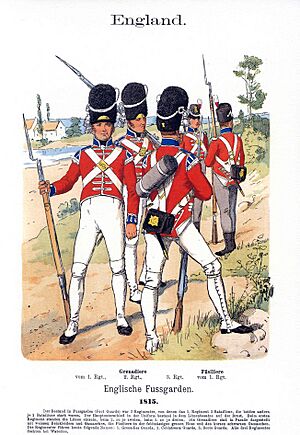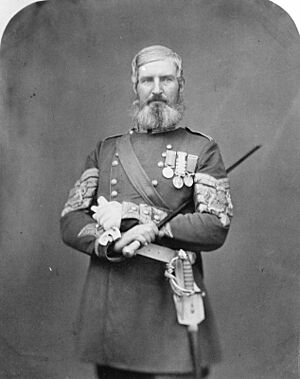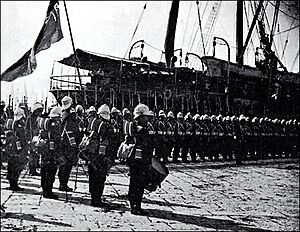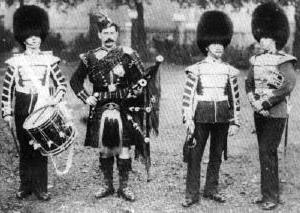History of the Scots Guards (1805–1913) facts for kids
The Scots Guards are a famous regiment in the British Army. They are part of the Guards Division. This article tells you about their history from 1805 to 1913.
Contents
Early History of the Scots Guards
The Scots Guards started way back in 1642. King Charles I ordered Archibald Campbell, 1st Marquess of Argyll to create a regiment for service in Ireland. It was first called the Marquis of Argyll's Royal Regiment.
After fighting in the Wars of the Three Kingdoms, the regiment broke up. But it was reformed in 1662 after the King returned to power. It was then known as the Scottish Regiment of Foot Guards. In 1686, it became part of the English Army. Later, Queen Anne renamed it the Third Regiment of Foot Guards.
Fighting in the Napoleonic Wars
In 1804, Napoleon Bonaparte became Emperor of France. Many countries formed groups, called Coalitions, to fight against him.
In 1805, the 1st Battalion of the Guards went to Hannover. In 1807, they helped capture the Danish fleet at the Battle of Copenhagen. This stopped the French from getting the ships.
In 1809, the 1st Battalion went to Portugal and Spain to fight in the Peninsular War. They helped cross the River Douro, which made the French army retreat.
Later that year, the 3rd Foot Guards fought in the very tough Battle of Talavera. The British were led by Lieutenant-General Arthur Wellesley, who later became the Duke of Wellington. The battle was fierce. The Guards showed great bravery, even when they suffered many casualties. They helped push back the French attacks. This victory earned the regiment its fifth battle honour.
Also in 1809, some companies of the 2nd Battalion went on the Walcheren Expedition. This campaign was very difficult because many soldiers got sick from a disease called Walcheren Fever.
In 1810, the 1st Battalion helped defeat a larger French force at the Battle of Buçaco. They then marched to the Lines of Torres Vedras, which were strong defenses protecting Lisbon. The British defeated the French there again.
In 1811, companies from the 2nd Battalion fought in the Battle of Barrosa. They quickly defeated the French, earning the regiment its sixth battle honour. The 1st Battalion also won its seventh battle honour at the Battle of Fuentes de Onoro that same year.
In 1812, the 1st Battalion took part in the Siege of Ciudad Rodrigo. This was a French fortress. The Guards helped dig trenches in terrible weather. The final attack was very bloody, with hand-to-hand fighting. Despite heavy losses, the British captured the fortress.
Later in 1812, the 1st Battalion won a big victory at the Battle of Salamanca. They then took part in the Siege of Burgos. In 1813, the 1st Battalion won another major victory at the Battle of Vittoria. They also fought in the bloody Siege of San Sebastian. By late 1813, the British pushed into France itself, where the 1st Battalion fought successfully at places like Nive. Napoleon gave up his power in April 1814.
In March 1815, Napoleon escaped from exile and returned to France. The 2nd Battalion, 3rd Foot Guards, were in what is now Belgium. On June 18, they fought in one of the most famous battles ever: Waterloo. The battalion was part of the 2nd Guards Brigade.
The 3rd Foot Guards were positioned near Hougoumont Farm. The light companies of the Guards defended the farm itself. This farm was a very important spot on the British side.
The battle started around 11:00 am with a French attack on Hougoumont. The farm came under heavy cannon fire. The Guards defended bravely, pushing back the first French attack. In a second attack, some French soldiers broke through the main gate. But the Guards quickly shut the gate and fought them off.
More attacks came, including one from the east. The 3rd Guards fought hard and drove the French back. Even when the farm was set on fire, the defenders kept fighting. The Guards showed amazing bravery and skill, helping the British win at Waterloo. The Duke of Wellington praised them. The 3rd Guards lost over 200 men at Hougoumont, but they held the farm. Napoleon was defeated and sent to St. Helena, where he died.
After Waterloo, the 2nd Battalion stayed in France until 1816. In 1824, both battalions went to Dublin, Ireland. In 1826, the 2nd Battalion went to Portugal. That same year, the 1st Battalion went to Manchester because of troubles there. In 1831, King William IV gave the regiment a new name: the Scots Fusilier Guards.
The Crimean War
In 1854, the Crimean War began. Britain, France, and the Ottoman Empire fought against Russia. The 1st Battalion of the Scots Fusilier Guards went to the East. They landed in the Crimea in September.
Their first big fight was the Battle of Alma. The British and French were trying to reach the Russian naval base of Sevastopol. The battle was chaotic, with a lot of hand-to-hand fighting. The Scots Fusilier Guards were in the middle of the Guards Brigade. They faced a strong Russian attack and had to pull back, losing over 150 men. But the regiment's flag bearers bravely held their ground and helped rally the soldiers. The Guards then fired heavily on the Russians, causing them to retreat. The British retook their positions. The battle was bloody, but the British won. For their actions at Alma, the Scots Fusilier Guards earned a battle honour. Four of their men later received the Victoria Cross, the highest award for bravery.
In 1855, the regiment fought in another tough battle, the Battle of Inkerman. The British and French were attacked by many more Russian soldiers in thick mist. The British, though outnumbered, defended bravely. The Guards helped defend a key spot called Sandbag Battery. They fought valiantly against huge numbers of Russians. Inkerman was a victory, but it involved brutal hand-to-hand combat. The regiment earned its thirteenth battle honour for Inkerman.
The Scots Fusilier Guards also took part in the long Siege of Sevastopol, which lasted for a year. The city was finally captured in September 1855. The Crimean War ended in 1856, and the Scots Fusilier Guards returned home.
Troubles Far Away
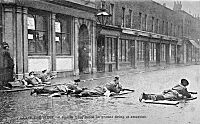
In 1862, the 2nd Battalion went to New Brunswick (now part of Canada) to help protect it during tensions with the United States. They returned home in 1864. In 1877, Queen Victoria changed the regiment's name to the more familiar Scots Guards.
In 1882, the 1st Battalion went to Egypt to deal with a revolt. A British force of 25,000 soldiers landed in Egypt. They won a decisive victory at the Battle of Tel el-Kebir. This led to the capture of Cairo. The Scots Guards earned the battle honours "Tel-el-Kebir" and "Egypt 1882". This was the last time the regiment carried its Colours (flags) into war.
In 1885, the 2nd Battalion took part in the Suakin Expedition in Sudan. They fought at the Battle of Hasheen and earned the battle honour Suakin 1885. They returned home later that year.
In 1899, the Boer War began in South Africa. The 1st Battalion went to South Africa and quickly saw action. They won battles at Belmont and Battle of Modder River. The battle at Modder River was very costly for the British. The Scots Guards earned a battle honour there. In December, they fought in the Battle of Magersfontein. The Boers were well-defended and caused heavy British casualties. The British lost this battle, which stopped their attempt to help the town of Kimberley. Also in 1899, a 3rd Battalion was formed in London, but it did not go overseas.
In 1900, the 2nd Battalion arrived in South Africa. They fought in the Battle of Paardeberg, where the Boer leader surrendered. The regiment also fought at the Battle of Driefontein and helped capture Johannesburg. The Scots Guards did many jobs in Africa, including manning blockhouses. In June 1902, the British won the war. The Scots Guards returned home, having shown their professionalism once more.
In 1901, King Edward VII became the first Colonel-in-Chief of the Scots Guards. In 1906, the 3rd Battalion was disbanded. When King Edward VII died in 1910, both battalions of the Scots Guards performed duties during the sad time. That same year, King George V became their new Colonel-in-Chief. In 1911, the regiment went to Egypt and returned home in 1913.
|


